Blooming Pomegranate Brings Treasure
8 min readAkind of fruit with brilliant flowers and husky fruits is growing everywhere, from the fertile central China to the beautiful mountain areas in Sichuan and Tibet; from the cold Northeast Plain to the mysterious ancient cities of Western Regions. When maturing season comes, there are fruits all over the mountains and plains, like the gold dropping off the Mt. Tianshan, which are golden, brilliant red and lovely to attract people. This fruit suits both refined and popular tastes and is almost impeccable. The sweet and sour taste makes people mouth-watering. Every boom season, small vendors would peddle along the streets, soliciting people to buy them actively. It is pomegranate, and the pomegranate variety in Xinjiang may be the best one.

It is said that the pomegranates were not introduced to inland China until Zhang Qian went to the Western Regions. There was a story about how the pomegranates were introduced to inland China. According to a legend, after Zhang Qian reached Anshi Guo in the Western Regions, he lived in a house in front of which stood a tree with fiery flowers in full bloom. Zhang Qian liked the tree very much and often stood aside to enjoy it. He then enquired and knew its name, pomegranate tree. Later, the drought came and the leaves and flowers of the pomegranate tree became increasingly withered. Zhang Qian carried water to water it from time to time, making the branches and leaves return green and the flowers colorful. After he had accomplished his mission, he refused the gold and gifts that the king of Anshi Guo gave him but required to bring the pomegranate tree back to the Central Plains. The king agreed with pleasure. But unfortunately, Zhang Qian was intercepted by the Huns on the way, and left the pomegranate tree behind in another country when he broke out of the encirclement. Zhang Qian felt so sad that he did not want tea and rice along the way until reaching the city of Chang’ an. When Emperor Wu of the Han Dynasty greeted him with officials of all ranks and descriptions,a beautiful young lady dressing in red skirt and green clothes appeared in front of the city gate like a fairy visiting to the world with lovingly pathetic expression on her eyes. Emperor Wu and the hundred officials were all surprised and did not know what happened. Zhang Qian was also shocked after fixing his eyes upon her. It was the girl who was driven away by Zhang Qian when he stayed in Anshi Guo. Originally, at the night before Zhang Qian left, the girl knocked his door and saluted to him, requesting to go to the Central Plains with her benefactor. Zhang Qian had no idea about how it was for a short while and mused that the maid must want to flee to the Central Plains with him. As he thought himself was an envoy of Han then, he couldn’t stir a scourge and persuaded the girl to leave. Unexpectedly, she went after him here. Zhang Qian asked,”Why did you leave Anshi Guo and caught up with us for such great distance?”That girl shed tear and replied,”I do not expect riches and honor but just want to return thegrace of watering. Robbed in the midway,I couldn’t go after you all the way.”She suddenly vanished from sight after finishing the words and turned into a flowery and leafy pomegranate tree. Zhang Qian was suddenly enlightened and reported to Empire Wu that he watered this pomegranate tree in Anshi Guo. Empire Wu was overjoyed and ordered flower workers to migrate the tree to the Imperial Garden. Since then, the Central Plains have had pomegranate trees. Of course, it was not Zhang Qian but the hard-working and kind-hearted people in ancient Western Regions who made the pomegranate trees widely cultivated. Perhaps, someone found the fruit of the pomegranate tree was so delicious in uncertain time and place. Thus pomegranate trees were planted one by one and are flourishing now.
In October of golden autumn, the most common sight in the streets of Urumqi is piles of pomegranates stalls. Grains of red pomegranates are connected to form a fiery slice under the autumn sunlight, making the gradually cooler autumn full of warmth.
Pomegranate is called Anar in Uygur. Decorating of the pomegranates was found in Niya’ sRelic and Loulan Relic in Turpan, from which we can infer that Xin jiang introduced and cultivated pomegranates at least 1,600 years ago. Rambling in pomegranates plantations in all parts of Xinjiang when pomegranates get mature, you will see red and yellow pomegranates bending the branches, amorous like fireballs and dazzling eyes. There are many varieties of pomegranate in Xinjiang, among which a kind of sweet pomegranate with big seeds is the most famous one. This kind of pomegranate is as big as an adult’s fist and weighs about 1kilogram per grain. After stripped, bright red pomegranate seeds which are plump and sweet and look like pearls and agates would all fall down to hands by being gently shaked. When you put all the seeds into mouth, bite gently and suck the juice, sour and sweet juice would flow and cycle round in your mouth and fully occupy your taste bud. Kashgar in Xinjiang teems with pomegranates which are sold to various regions every year.
Pomegranates are delicious, but it is troublesome to eat pomegranate with seeds. So pomegranate juice squeezed by machine comes into fashion in bazaars. In all sizes ofbazaars in Xinjiang, you can see semi-automatic pressure juice machines with a crank everywhere. The pomegranate seeds are first put into an iron trough. And when you turn thehandle, the iron plate will squeeze the pomegranates and then pink pomegranate juice will flow through a sub-flow mouth at the bottom into cups. Pomegranates in Kashgar and Hotan areas are the best variety in Xinjiang. Piyalema Township in Hotan is China’s famous hometown of pomegranate. Piyaman pomegranates are delicious with beautiful fruit shape and exported overseas.

Pomegranate is a kind of fruit with very nice appearance and quite delicious taste. Not only the appearance is booming as a symbol of good luck, but also the flesh is bright red like agates. Pomegranates are very attractive with fresh sweet and light sour taste. Some friends may feel troublesome to eat pomegranates and spit seeds out one by one. Actually, it is not true. Nutrition experts point out that spitting pomegranate seeds will greatly waste the nutrition of pomegranate. Pomegranate seeds are rich in vitamin C, polyphenols and flavonoids, which are the powerful antioxidants to delay senescence and prevent and remit diseases caused by aging. Pomegranate seeds are also rich in vitamins which can not only make the skin whiter and tender, but also increase the flexibility of blood vessels to prevent cardiovascular and cerebrovascular diseases. Polyphenols and flavonoids can help the skin resist free radical damage and prevent premature formation of wrinkles and helpfade the age spots. Eating pomegranate seeds can also help protect the joints, because the nutritional substances therein can promote secretion of the joint lubricating fluid. In addition, pomegranate seeds can promote bowel movements, and those who have this problem may have a try. But it is important to note that the pomegranate seeds are not easy to be digested. Those who suffer from indigestion can chew the pomegranates with seeds, and then spit them out. Because different varieties of pomegranates have soft or hard seeds, it depends on the situation to eat pomegranates. People who are not accustomed to them can just eat a few. And the old with bad teeth and gastrointestinal function cansqueeze and smash them to drink the juice. If you put a pomegranate and half an apple together to squeeze juice, its nutritional value will be doubled.
Pomegranate not only tastes sweet, but also has a deep original relation with the Chinese clothing culture. In Wu Qi Qu written by Emperor Yuan of the Liang Dynasty(502A.D. to 557A.D.), there is such a description as “hibiscus for the belt and pomegranateflowers for the skirt”to draw forth the literary quotation of “good graces”. Women in ancient times preferred to dress themselves in pomegranate red when the pigments of red skirts were mainly extracted from pomegranate flowers. So people also called the red skirts”good graces”. As time passed, the “good graces”had become the antonomasia of young and beautiful girls in ancient times. Therefore, such ridicule words appeared that”dying under the good graces is also romantic”.
During June to July of each summer, pomegranate trees in fields in Karghalik of Xin jiang compete to bloom with luxuriant leaves and numerous flowers. Local farmers dance trippingly in fields when they stop working to have a rest, which constitutes extremely beautiful and peaceful idyllic scenery. Crimson, red and dark red pomegranate flowers one after another bloom deeply and shallowly, facing the summer sunshine. Peoples laughter and noise accompanied by the “click”sound of cameras as well as butterflies and bees shuttling back and forth with buzzing songs form a wonderful amusement picture of pastoral scenery. By the end of September every year, it is time to harvest pomegranates. At the time, large and small pomegranates hang thick on the branches, just like red lanterns one after another in Karghalik. Big pomegranates have already cracked lips, revealing a mouthful of small teeth, white with pink. Locals say that if someone cuts off the whole branch during picking pomegranates and hangs it in the room, happiness will come quietly beside him. Karghalik is known as a “pomegranate town”, where the soil property is ideal for growing pomegranates with a shorter frost period, long sunshine hours and a large temperature difference between day and night. Pomegranates in Karghalik are basically divided into two categories, namely sour ones and sweet ones. Particularly, Dnika pomegranates in Baxireke Township are the best with bigger fruits and full seeds, which are good for fresh eating and very popular among consumers.
In mid-autumn season, going deep into the pomegranate orchards, you will see pomegranate trees one after another trimmed in order, greening a large tract of land with layer upon layer and thickly dotted leaves. Clusters of red pomegranate flowers wittily stretch forward their heads and look around under the cover of the bright green leaves. How to describe that trace of color? It looks like burning on the skirts of slim girls, splendid and ardent, dazzling people’s eyes. Many Uygur girls will wear pomegranate flowers on their ears, dancing under the trees, to attract people’s eyes.A thousand years ago, when Beauty Yang in red skirt embroidered fully with pomegranate flowers passed by the poolside of Huaqing Chi with slender and graceful steps, the floating secret fragrance attracted all officials to worship on bended knees one after another. Thus the allusion”prostrating off her feet”appeared. Poet Li Shangyin in the Tang Dynasty wrote in the poem,”pomegranate branches are graceful while fruits are numerous; pomegranate membrane is ucid while seeds taste fresh”, which made the graceful posture of pomegranate trees stand vividly on the paper. The blooming period of pomegranates is very long from May to the end of July. The flowers are brilliant like rosy clouds. Looking the eggplant-shaped flowersingly from the top, you will find it dehiscing into four petals. It seems that someone carves a flower vase with red agate, and skillfully arranges flowers in it.









